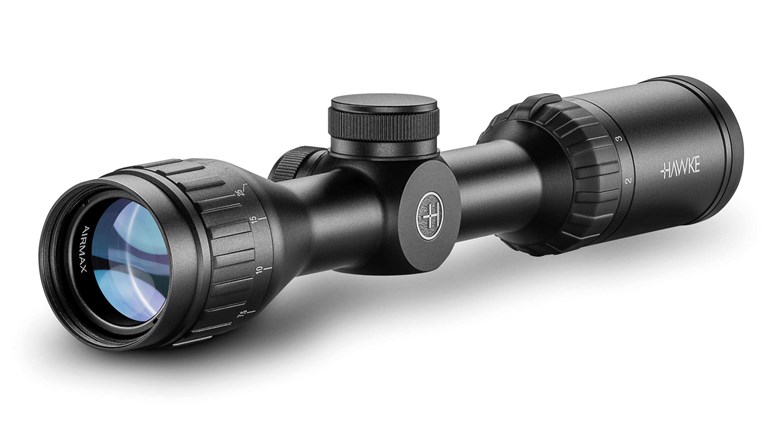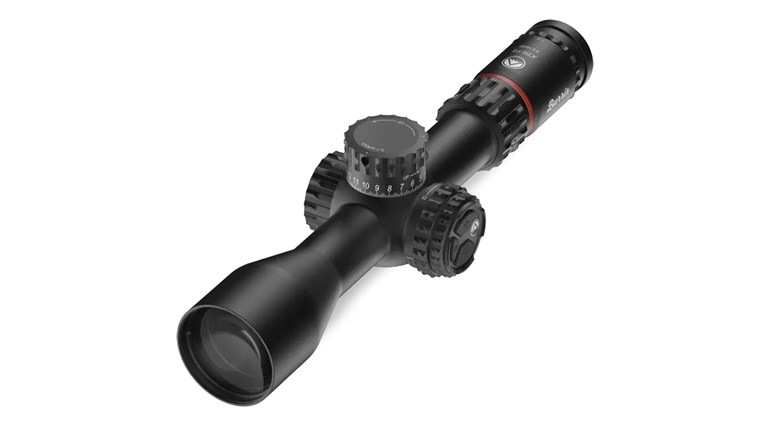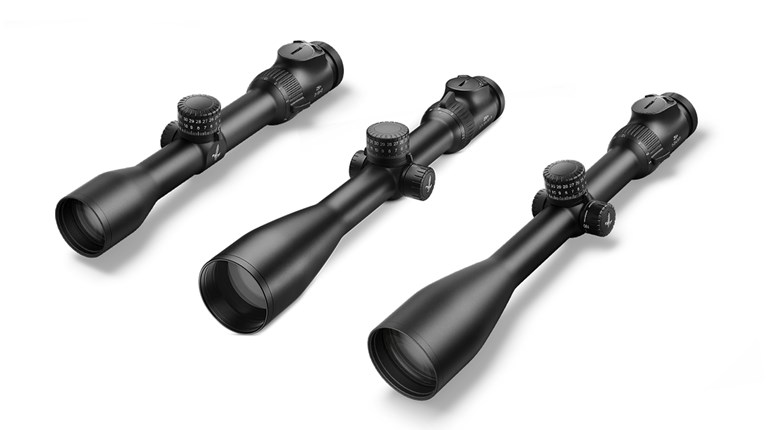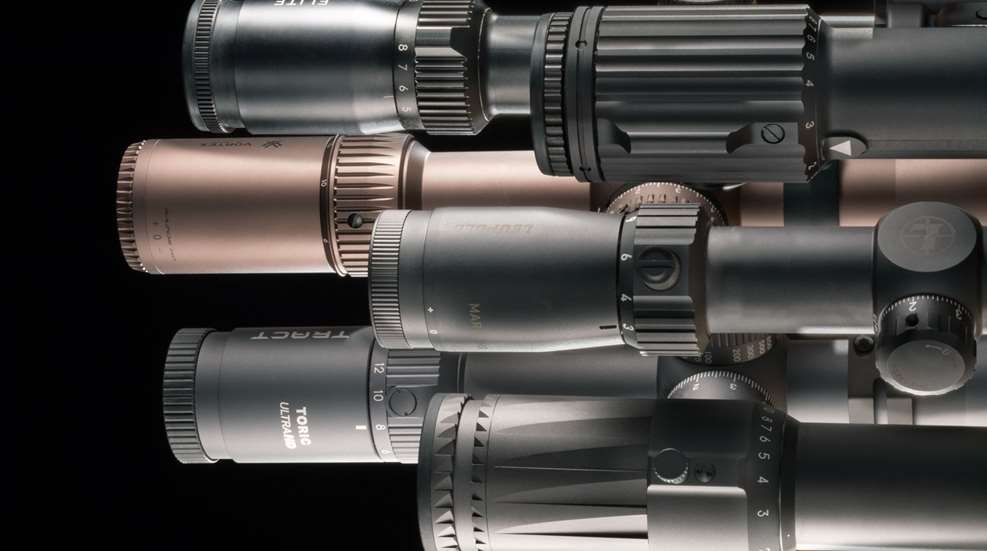
Erector is one of those optical terms that often makes people have a quiet laugh. Trying to explain that an erector’s job is to make an image erect seldom helps. Neither does pointing out that “erect” simply means “upright” in this case. Nevertheless, every riflescope you have does indeed contain an erector optical system, and every variable-power riflescope has a characteristic called an erector ratio. Technically, prismatic riflescopes do not really have an erector since the prism assembly, among other things, gets the image oriented the right way. Fixed-power riflescopes that are not prismatics do have an erector-optical system, but a simpler one than found on variable-power models. For the purposes of this discussion, assume we are talking about conventional, variable-magnification riflescopes.
The vast majority of riflescopes made today have variable magnification, and the ratio of highest-to-lowest magnifications is often referred to as the optic’s erector ratio. To understand what that is, see the diagram of what the inside of a riflescope looks like shown on this page.
That image is based on one in a manual for a Hensoldt 4-16x56 mm scope, which has a rather sophisticated (and still competitive, despite being in production for many years) optical design for its time. As the designation suggests, it has a 4X erector ratio (the high magnification of 16X divided by the low magnification of 4X). The diagram calls out the three optical systems that make up a riflescope: objective, erector and eyepiece. The objective is what is looking out toward the world (toward the left of the diagram). Its function is to form the image of whatever the riflescope is pointed at in the first focal plane (FFP). There are two focal planes inside a riflescope: one between the objective and the erector, and the other between the erector and the eyepiece. The erector optical system takes a portion of the image from the FFP, magnifies it, flips it around and re-creates it in the second focal plane (SFP).
On high magnification, it samples a very small portion of the FFP image. On low magnification, it samples a larger one. If the erector ratio is 4X, as in the Hensoldt, that means the FFP image sampled on low power is four times larger in diameter than the one sampled on high power. The erector system sits inside an erector tube (not shown in the diagram) that is set-up as a telescoping assembly driven by helicoids. When you change the magnification of the riflescope, the lens groups in the erector system move with respect to each other. The relative position of those lenses is what defines the exact magnification at each setting.
Finally, the eyepiece takes the image from the SFP and projects it out to your eye. Eyepiece design is usually quite complex, but for the purposes of this discussion, it is relatively unaffected by the differences in erector and objective designs. As long as those two are capable of delivering a high-quality image to the SFP, a well-designed eyepiece will deliver it to the eye.
Still, all three of these optical systems have to work seamlessly together, and changes in one often necessitate changes in the other two. Most critically, changes in the erector make direct impact on the design of the objective. Generally, riflescope design has been continuously evolving, both optically and mechanically. In the time since I first started paying attention, a bit more than 20 years ago, some of the biggest changes have been driven by manufacturers pushing toward ever-larger magnification (i.e. erector) ratios. If I were to guess, the biggest reason for this push has been marketability. The benefits of a higher erector ratio are obvious: it makes for a more versatile product. The allure of one riflescope that can do nearly everything is quite apparent. If you are looking to convince the consumer that they should dispose of their perfectly functional riflescope in favor of the latest and greatest, versatility is an appealing argument to make.
The downsides are less obvious if you are just browsing through the specs on the internet. At this point, every self-respecting conspiracy theorist will likely declare they will never buy another high-erector-ratio riflescope again due to obvious malicious interference from corrupt corporate interests. If we follow that logic, we might as well all just go back to fixed-power scopes or take it one step further to iron sights. That does have certain nostalgic appeal, but is absolutely preposterous from any sort of a practical standpoint. The right approach is to have a clear understanding of the compromises, so you can make an intelligent choice for your requirements.
For example, a standard hunting scope 25 years ago was either a 3-9X or 2.5-10X design, sporting a 3X or 4X erector ratio. Looking at modern hunting riflescopes in the same inflation-adjusted price range reveals more ambitious configurations along the lines of 2-10X, 3-15X, 2-12X, 2-16X, etc. Arguably, the most flexible general-purpose hunting/DMR scope today is the recently introduced March-FX 1.5-15x42 mm with a 10X erector ratio, dual focal-plane reticle, side focus and reticle illumination. That all sounds good on paper, but we know there is no such thing as free lunch. In other words, what are we compromising?
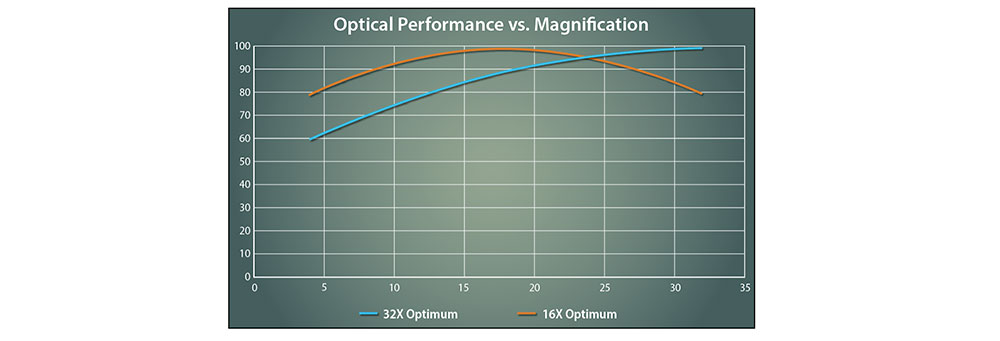
Some compromises are fairly obvious. For example, there is the basic problem of optical optimization. When you change the magnification of a riflescope, lenses move. The way optical designs work, the image quality can only truly be optimized at one particular setting. One of the more difficult things about optical design is making sure there isn’t too much performance fall-off at other magnification settings. You simply can’t have it perfectly optimized at all magnifications in the same design. Traditionally, many riflescopes were tuned to be as perfect as possible on the highest magnification. They might still be very good at other settings, but not optimal. The thinking there is that the highest magnification is the most challenging, so that is where we should be optimizing things. That theory has its merits, but some PRS-oriented designs are now optimized somewhere toward the middle of the magnification range, partially because that is how these riflescopes are used most frequently and partially because there is less relative fall-off toward the edges of the magnification range.
The larger the erector ratio, the more difficult it is to maintain consistent image quality across the whole magnification range. In many modern riflescopes that have a 10X erector ratio, if you pay attention, you’ll notice there are one or two spots somewhere in the magnification range where the image becomes blurry. That essentially means that the optical designer decided to sacrifice a particular setting to optimize the other ones a little better. Given the complexity of the design, it is a reasonable compromise. If the image happens to be blurry on 3.2X, for example, but nicely optimized on 3X and 3.4X and everywhere else, it will not make a noticeable impact on real-world performance. Just avoid using it on 3.2X.
Also, it is worth pointing out that optical complexity often translates into mechanical difficulties. You usually have more lens elements to work with (the diagram on p. 43 is for a 4X-erector scope; 8X or 10X erectors often have an extra lens group, so there are three separate lens bundles all moving back and forth at the same time) and their positioning tolerance is frequently tighter. Moreover, that positioning has to be nicely centered at all times or SFP scopes will have point-of-aim shifts as you adjust magnification. That is not an issue for FFP scopes, but it is still a little disconcerting to have your primary-aiming point and the image move laterally when making magnification adjustments. Even packaging the whole thing together becomes an issue, since there is more fixturing to hold all the lenses inside the limited internal space of a riflescope. Doing so consistently under recoil and rough handling is often problematic, especially when looking at budget scopes.
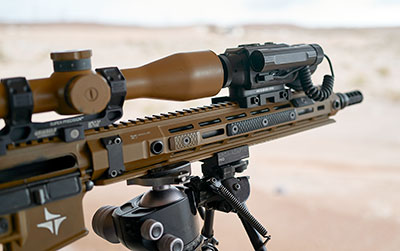
Naturally, weight and size go up with higher erector ratios. Extra lens elements add weight. Additional mechanical complexity does the same thing: all those lenses have to be held by mechanical assemblies. They all add weight, but they also need space. As the erector ratios increase, available real estate inside the main tube becomes increasingly important. All else being equal, a 3-9x42 mm riflescope can be made lighter than a 2-16x42 mm. The former is also easier to make robust.
Going back to optical design, one of the characteristics that does not get a lot of coverage, but really should, is depth-of-field. One of the side effects of higher-magnification-ratio designs is that they often require a shorter-focal-length-objective-lens system. Shorter focal length with the same objective diameter means lower F-number. Photo-graphers call these kinds of lenses “Fast.” They are a little harder to design in terms of pure performance, and they produce a shallower depth-of-field. For example, the Hensoldt scope diagram shows eight lens elements in the objective-lens system. That was an unusually sophisticated objective for the time. Hensoldt mostly makes riflescopes to the requirements of various military tenders, and that 4-16x56 mm was notably shorter than its similarly configured contemporaries because of those military requirements. High-erector-ratio scopes often take complexity to the next level. Not only do they often require shorter-focal-length objectives, but they also require these objectives to be extremely high performing. In a high-erector-ratio riflescope, when the magnification is set on maximum, the FFP spot being sampled is very small, requiring exceptionally high levels of sharpness, contrast and color fidelity.
What are the practical ramifications of a shallow depth-of-field? Typical riflescopes without parallax adjustment (parallax adjustment is really image focus that is mis-named for historical reasons) are usually set up at the factory to be focused somewhere between 100 and 200 yards. However, if you examine it carefully, you’ll realize that the image looks acceptably sharp a good bit closer than and farther than that. The range between close-focus and far-focus distances is depth-of-field. If it is too shallow, the riflescope needs parallax/image-focus adjustment to compensate.
On the eyepiece side, eye-relief flexibility (often referred to as the eyebox) also suffers with high-erector-ratio designs, although several modern high-end riflescopes seem to have resolved this problem to some degree. For example, the Vortex Razor Gen3 6-36x56 mm is exceptionally easy to get behind. However, it will put a bigger dent in your bank account. It may be a while before this level of performance propagates to lower price ranges.
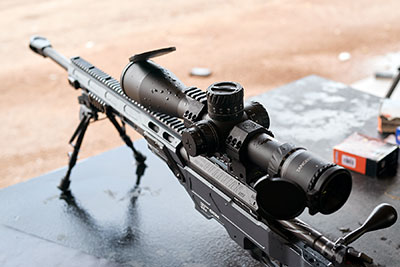
Everything we have gone over so far may sound like an indictment of high-erector-ratio riflescopes, but that is not my intention at all. When I went to examine what kinds of riflescopes I have on hand, I found everything from fixed-power designs to 3X erector ratios to 10X and everything in between. They all have their place and all work well for their intended applications. One thing that is extremely important to keep in mind is that when a particular design is not perfectly optimized due to a higher erector ratio, that does not mean it is optimized badly. It might mean a barely perceptible performance difference. For some applications, optical performance is everything, while for others it is an acceptable area to compromise for flexibility. For someone who wants a general-purpose riflescope that works for multiple applications while still matching well with commercially available thermal clip-ons, for example, broad magnification range is more important than for a dedicated sheep hunter who will never shoot at night or at anything closer than 250 yards. The important thing here is managing expectations in terms of both price and performance.
A couple of optical designers I know privately believe that a 5X erector ratio is about as high as you can go if you want image quality close to optimal across the board. On the other hand, I have seen more than one riflescope with a higher magnification ratio than that perform exceedingly well. In the end, it all comes down to what constitutes an acceptable compromise. It may very well be different for different people. With optics, everything is a balance, so you have to think what matters the most to you: magnification range, image quality, weight, for-giving eye relief or, last but certainly not least, price. The improvements in rifle-scope design and manufacturing have greatly expanded the options available to us, but you still can’t always have your cake and eat it, too.
Most fundamentally, the more complicated the design of a riflescope, the more suspicious you should be if it has a low price. Things that look too good to be true usually are.
About the Author
ILya Koshkin’s professional background spans a broad range of topics from fiber optics to imaging systems to technical marketing and management. He has been involved with design, calibration and improvement of every type of electro-optical system possible, including lasers, thermal cameras, airborne targeting systems, satellite imagers, movie cameras, etc. Bridging the gap between engineers and shooters has been his passion project for the better part of the last two decades. He has been involved with firearms, shooting and Second Amendment advocacy since college. Growing up in the Soviet Union, Koshkin has a better understanding than most of the importance of private firearm ownership to securing liberty.












